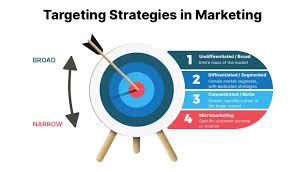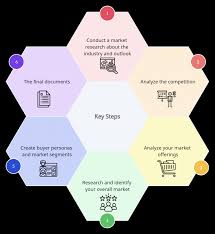Exploring the Various Types of Target Market: A Comprehensive Guide
Understanding Different Types of Target Market
When it comes to marketing your products or services, identifying and understanding your target market is crucial for success. A target market refers to a specific group of consumers that a business aims to reach with its marketing efforts. Here are some common types of target markets:
Demographic Target Market
This type of target market focuses on characteristics such as age, gender, income level, education, occupation, and marital status. Understanding the demographics of your target market can help you tailor your marketing strategies to better appeal to their needs and preferences.
Psychographic Target Market
Psychographic segmentation involves dividing the market based on psychological traits, lifestyle choices, values, interests, attitudes, and behaviours. This type of targeting helps businesses create more personalised and relevant marketing messages that resonate with their audience on a deeper level.
Geographic Target Market
Geographic segmentation involves dividing the market based on geographical location such as region, city size, climate, population density, and cultural preferences. Understanding the geographic distribution of your target market can help you tailor your marketing campaigns to suit their specific needs and preferences.
Behavioural Target Market
This type of targeting focuses on consumer behaviour such as purchasing habits, brand loyalty, usage rate, benefits sought, and decision-making processes. By understanding the behavioural patterns of your target market, you can create targeted marketing campaigns that drive engagement and conversion.
B2B (Business-to-Business) Target Market
If your business caters to other businesses rather than individual consumers, identifying a B2B target market is essential. Factors such as industry type, company size, purchasing power, decision-making process, and buying motives play a key role in targeting businesses effectively.
In conclusion, understanding the different types of target markets is essential for developing effective marketing strategies that resonate with your audience and drive business growth. By identifying and segmenting your target market based on demographics, psychographics, geography, behaviour or B2B criteria, you can create targeted campaigns that deliver tangible results.
Understanding Different Types of Target Markets: A Guide to Common Questions
- What are the 5 target markets?
- What are the 4 types of target audience?
- What are examples of target markets?
- What are the 4 types of target market?
- What are the 3 common target markets?
- What are the 4 target markets?
What are the 5 target markets?
When it comes to identifying target markets, businesses often focus on five main types to tailor their marketing strategies effectively. These include demographic target market, which considers factors such as age, gender, income, and education level; psychographic target market, which delves into lifestyle choices and attitudes; geographic target market, which looks at location-based preferences; behavioural target market, which analyses purchasing habits and brand loyalty; and B2B target market for businesses catering to other businesses. Understanding these five key target markets allows businesses to refine their marketing efforts and connect with their audience in a more meaningful way.
What are the 4 types of target audience?
When it comes to identifying target audiences, businesses often categorize them into four main types based on different criteria. These include demographic target audience, which focuses on characteristics such as age, gender, income level, and education; psychographic target audience, which considers lifestyle choices, values, and attitudes; geographic target audience, which looks at location-based factors such as region and climate; and behavioural target audience, which analyses consumer purchasing habits and decision-making processes. Understanding these four types of target audiences is crucial for businesses to tailor their marketing strategies effectively and connect with their intended customers in a meaningful way.
What are examples of target markets?
When considering examples of target markets, it is important to understand that they can vary greatly depending on the nature of the business and its products or services. For instance, a luxury skincare brand may target affluent women aged 30-50 who value premium quality and exclusivity. In contrast, a fast-food chain might target young adults and families looking for quick and affordable meal options. Another example could be a tech company targeting tech-savvy millennials interested in the latest gadgets and innovations. These examples illustrate how businesses define their target markets based on demographics, psychographics, behaviour, and other factors to effectively reach and engage with their intended audience.
What are the 4 types of target market?
One frequently asked question regarding types of target market is, “What are the 4 types of target market?” The four main types of target markets are demographic, psychographic, geographic, and behavioural. Demographic target market segmentation focuses on characteristics such as age, gender, income level, and education. Psychographic segmentation delves into psychological traits and lifestyle choices. Geographic targeting considers location-based factors like region and climate. Behavioural targeting looks at consumer behaviour patterns such as purchasing habits and brand loyalty. Understanding these four types of target markets is essential for businesses to tailor their marketing strategies effectively and connect with their intended audience.
What are the 3 common target markets?
When it comes to identifying target markets, three common categories that businesses often focus on are demographic, psychographic, and geographic target markets. Demographic target market segmentation involves characteristics such as age, gender, income level, education, and occupation. Psychographic targeting delves into the psychological traits, lifestyle choices, values, interests, and behaviours of consumers. Geographic targeting focuses on factors like region, city size, climate, and cultural preferences. By understanding and utilising these three common types of target markets effectively, businesses can tailor their marketing strategies to reach the right audience with the most relevant messaging.
What are the 4 target markets?
When considering the types of target markets, it is common to refer to four main categories: demographic, psychographic, geographic, and behavioural target markets. Each of these target market types focuses on different aspects of consumer characteristics and behaviour to help businesses tailor their marketing strategies effectively. Demographic target market segmentation involves factors such as age, gender, income, and education level. Psychographic segmentation delves into consumers’ values, interests, and lifestyle choices. Geographic targeting considers the location and cultural preferences of the audience. Behavioural targeting looks at purchasing habits, brand loyalty, and other behavioural patterns. By understanding and utilising these four key target markets, businesses can create targeted campaigns that resonate with their audience and drive success.




